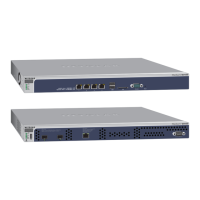Manage Security Profiles and Profile Groups
133
ProSAFE Wireless Controller
The newly created profile displays onscreen, and the tab for the new profile is
automatically selected to let you configure the new profile.
Note: The authentication server settings that you specify on the Authentication
Server page affect the selections that are available from the Network
Authentication menu. For more information, see Manage
Authentication Servers and Authentication Server Groups on page 140.
If your selection from the Network Authentication menu requires
authentication, a corresponding Authentication Server field displays.
10. Configure the settings as described in the following table.
Setting Description
Profile Definition section
Name Enter a unique name to identify the profile.
This value can be up to 32 alphanumeric characters. Use meaningful profile
names instead of the default names. The default profile names are Profile1,
Profile2, and so on, through Profile8.
Wireless Network Name
(SSID)
Enter a unique name for the WiFi network associated with this profile. The
length of the SSID is restricted to a maximum of 31 characters. You can you
use all characters except for the following: space, single quotation mark, and
double quotation mark.
Broadcast Wireless
Network Name
Select the Yes radio button to enable broadcast of the SSID.
This is the default setting.
Select the No radio button to disable broadcast of the SSID, in which case only
users who know the correct SSID can connect to the access point.
Client Authentication section
Note: The options that display onscreen depend on your selection from Network Authentication menu.
Network Authentication From the menu, select the authentication type to be used.
Table 10 on page 137 lists all authentication types.
Data Encryption From the menu, select the data encryption type to be used.
The options available for data encryption as well as other requirements such as
entering a key or passphrase depend on the network authentication settings.
Table 10 on page 137 lists all data encryption options.
Wireless Client Security
Separation
From the menu, select Disable to prevent associated WiFi clients from
communicating with each other, or select Enable to allow such communication.
WiFi client separation is intended for hotspots and other public access
situations.
VLAN Enter the VLAN ID to be associated with this security profile.
This VLAN ID must match the VLAN ID that other network devices use.

